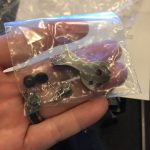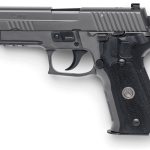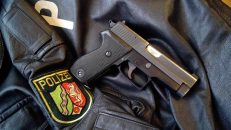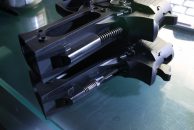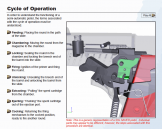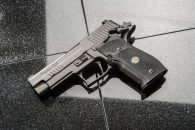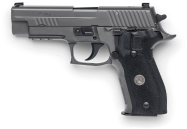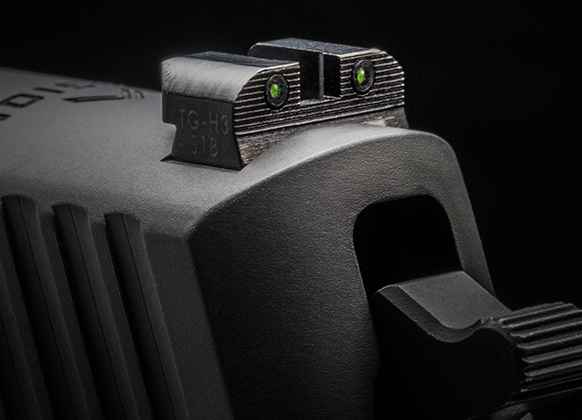
To help ease confusion, I’ve written this brief reference guide for SIG Sauer sight numbers and sight heights. Keeping them straight can be confusing, so I wrote this guide as much for myself as anyone else. 🙂
Which SIGs Use Which Heights?
For classic P-Series pistols, the “general” rule for what are considered the “standard” SIG sight numbers is actually based on the gun’s caliber, not the model. The standard SIG sight numbers for particular calibers are:
- 9mm & .357 SIG: #8 front / #8 rear
- .40 S&W & .45 ACP: #6 front / #8 rear
For the SIG X-RAY sights (like the ones that come on the Legion series pistols), things seem to be a bit different, and the model does seem to matter:
- P226 Legion 9mm (DA/SA & SAO): #8 front / #8 rear
- P226 Legion .40 DA/SA & P229 Legion 9mm DA/SA: #6 front / #6 rear
Notice above that I put the words “general” and “standard” in quotes… because these are generally what SIG uses, and what they say is the standard… but in practice, I’ve actually seen all sorts of variability. Both the 9mm and .40 versions of the SIG P320C come with #6 front / #8 rear from the factory, while the full-size P320 comes with #8 front / #8 rear. The 9mm SIG M11-A1 also breaks the “rule” and comes with #6 front / #8 rear.
So if your P229 .40 came with #8 front and #8 rear, but shoots fine as-is, there’s no need to rush out and change your front sight to a #6. These are the general rules, but if you come across an exception that works for you… go with it.
Whatever the reason for all the variability, it should be obvious by now to refer to the above “rules” in general terms only. Chances are, your factory sights will be either #6 and/or #8, with the only guarantee being that the front won’t be a higher number than the rear. But beyond that, it almost seems like anything goes!
For example, in preparation for this article, I recently asked members of the SIG Sauer Legion Owners Facebook Group to post their Legion’s sight numbers. Two members, both with 9mm P226 Legion SAO pistols posted different front sight numbers:
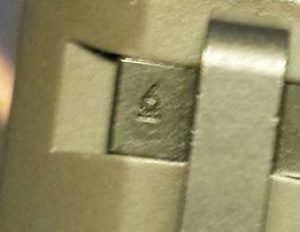
P226 Legion SAO (9mm) with a #6 front sight from the factory
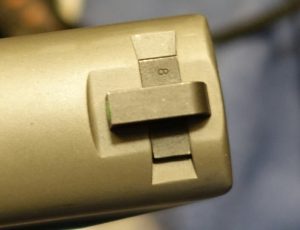
P226 Legion SAO (9mm) with a #8 front sight from the factory
What’s most important is to know what your SIG currently has, and whether those work for you. To find what sights your SIG currently has, look for a small number, usually on the left side of the front sight, and the right side of the rear sight (on the SIG X-RAY sights, both are on the right).
Some shooters prefer non-standard sight heights, and whatever works for them (or you) is fine. If you want to change your sight heights to move your groups up or down, it’s your gun. Do what you want with it.
SIG Sauer Sight Numbers and Heights
With SIG sight numbers, a #6 front sight is not the same height as a #6 rear sight. The system seems counter-intuitive at first, but if you look at the following table and can see the patterns, you’ll figure it out. And if you can’t, don’t worry — I explain everything after the table. 🙂
This table shows the actual heights of each SIG front and rear sight number. The front heights shown are the actual heights of the sight — including the dovetail base, not just the blade.
| SIG Sight Number | Front Sight Height | Rear Sight Height |
|---|---|---|
| #4 | N/A | 5.24 mm / 0.210 in |
| #5 | 6.01 mm / 0.235 in | 5.52 mm / 0.220 in |
| #6 | 5.88 mm / 0.230 in | 5.80 mm / 0.230 in |
| #7 | 5.74 mm / 0.225 in | 6.07 mm / 0.240 in |
| #8 | 5.60 mm / 0.220 in | 6.35 mm / 0.250 in |
| #9 | 5.46 mm / 0.215 in | 6.62 mm / 0.260 in |
| #10 | 5.32 mm / 0.210 in | 6.9 mm / 0.270 in |
Note from the table that:
- The higher the front sight number, the lower the sight’s height.
- The higher the rear sight number, the higher the sight’s height.
This seems weird at first, until you realize how the different sight numbers will affect a round’s point of impact. Always remember that:
- As numbers go up, your groups go up.
- As numbers go down, your groups go down.
This is true regardless of whether you change only the front sight, only the rear sight, or both. Again, higher numbers (for either sight) mean higher groups, while lower numbers (for either sight) mean lower groups.
Optimal SIG Sauer Sight Picture
Modern “three-dot” SIG Sauer pistol sights are set up from the factory in a “combat sight picture” configuration so that when all three dots are aligned, the POA (Point of Aim) is in the center of (or “behind) the front dot, as shown in Sight Image 3 below:
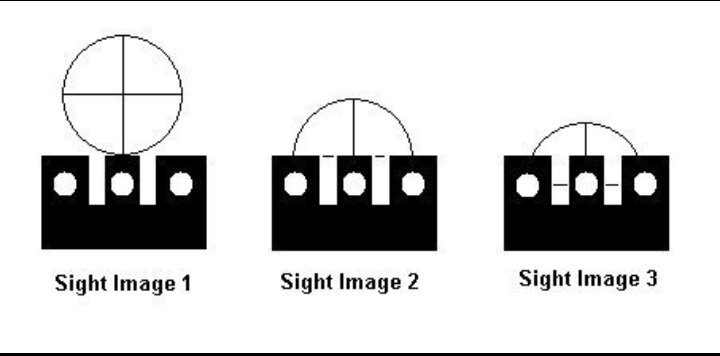
SIGs are set up at the factory with Sight Image 3
Earlier West German SIGs used Von Stavenhagen sights, which are similar in that when properly aligned, they place POA directly “behind” the front dot:
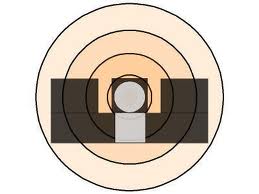
Von Stavenhagen sight picture
SIG Sauer pistols are also set up from the factory so that at a distance of 25 yards, the Point of Aim (POA) is the same as the Point of Impact (POI) — meaning that with a target at 25 yards, the round should impact the target exactly where the sights were aimed, with no compensation needed for bullet drop. At distances beyond 25 yards, the POI will be progressively lower than the POA.
How Different Sights Affect POI
If you’re considering changing your sights to move your groups up or down, understand that changes to the rear sight affect your 25 yard point-of-impact twice as much as an equal change to the front sight.
To figure out exactly how different numbered sights will change your POI as compared to your current sights, keep in mind that at 25 yards, each sight number change is “worth” one inch for the front sight and two inches for the rear sight. So at 25 yards:
- Raising the front sight one number raises the POI by 1″
- Lowering the front sight one number lowers the POI by 1″
- Raising the rear sight one number raises the POI by 2″
- Lowering the rear sight one number lowers the POI by 2″
Again, the front sight is worth 1″ and the rear sight is worth 2″ for every number change. This means that at 25 yards, the following sight combinations should all have the same POI on the same gun:
- 6 front / 8 rear
- 8 front / 7 rear
- 10 front / 6 rear
If you understand why the above is true, then you’re well on your way to understanding the SIG sight numbering system!
Also, because a single number change in the rear sight affects POI greater than a single number change to the front sight, if your 25 yard POI is off by more than two inches, it’s best to change your rear sight first, then “fine tune” with changes to the front.
How to Adjust or Change Your SIG Sights
Any qualified gunsmith will be able to remove, install, and/or adjust the sights on your SIG Sauer pistol. Some owners prefer to do it themselves in the “old school” style with a hammer and punch. I prefer use a SIG Sight Pusher like this one. The following video (taken from my P226 Upgrade Video Series) shows how easy it is to remove, install, and adjust SIG P-series sights with a sight pusher:
In 2002, SIGARMS (which became SIG Sauer Inc. in the United States in 2007), published this card with tips on sight adjustment and replacement:
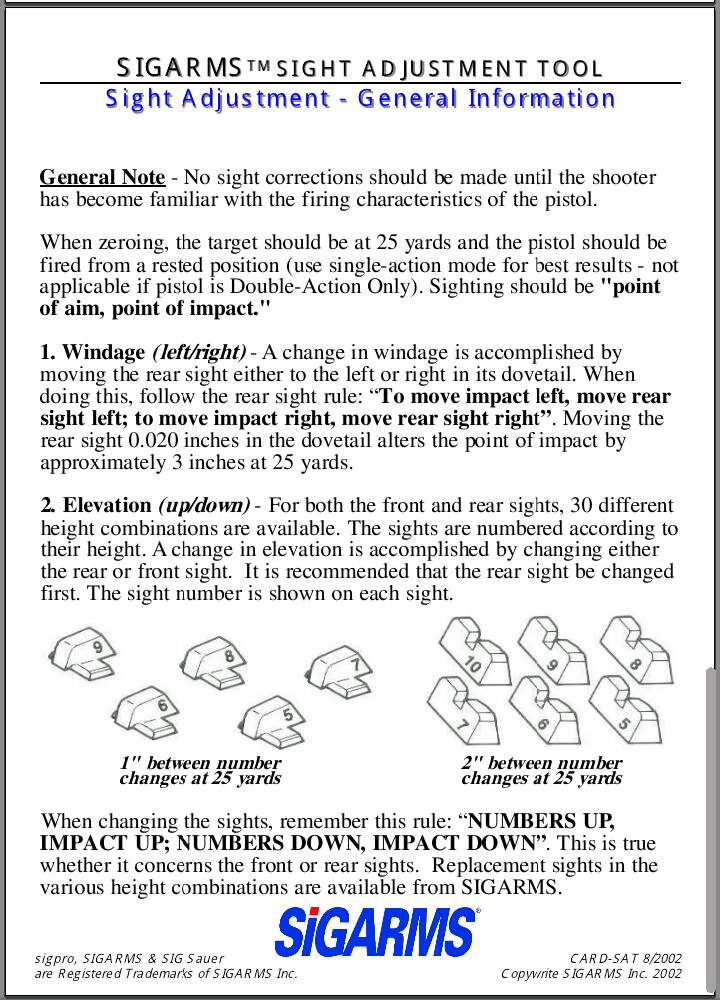
As always, I welcome your questions, comments, corrections, and feedback below!

